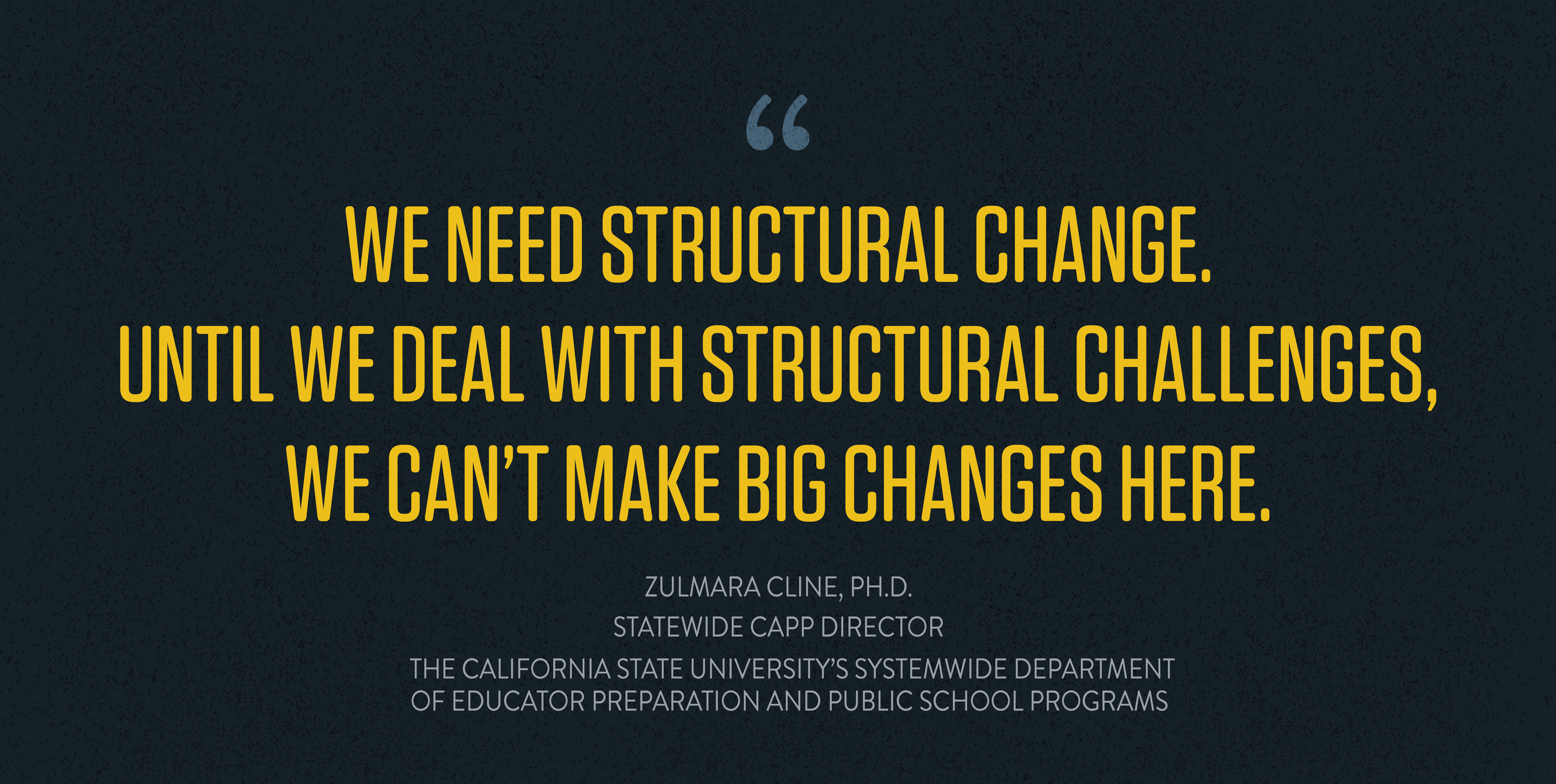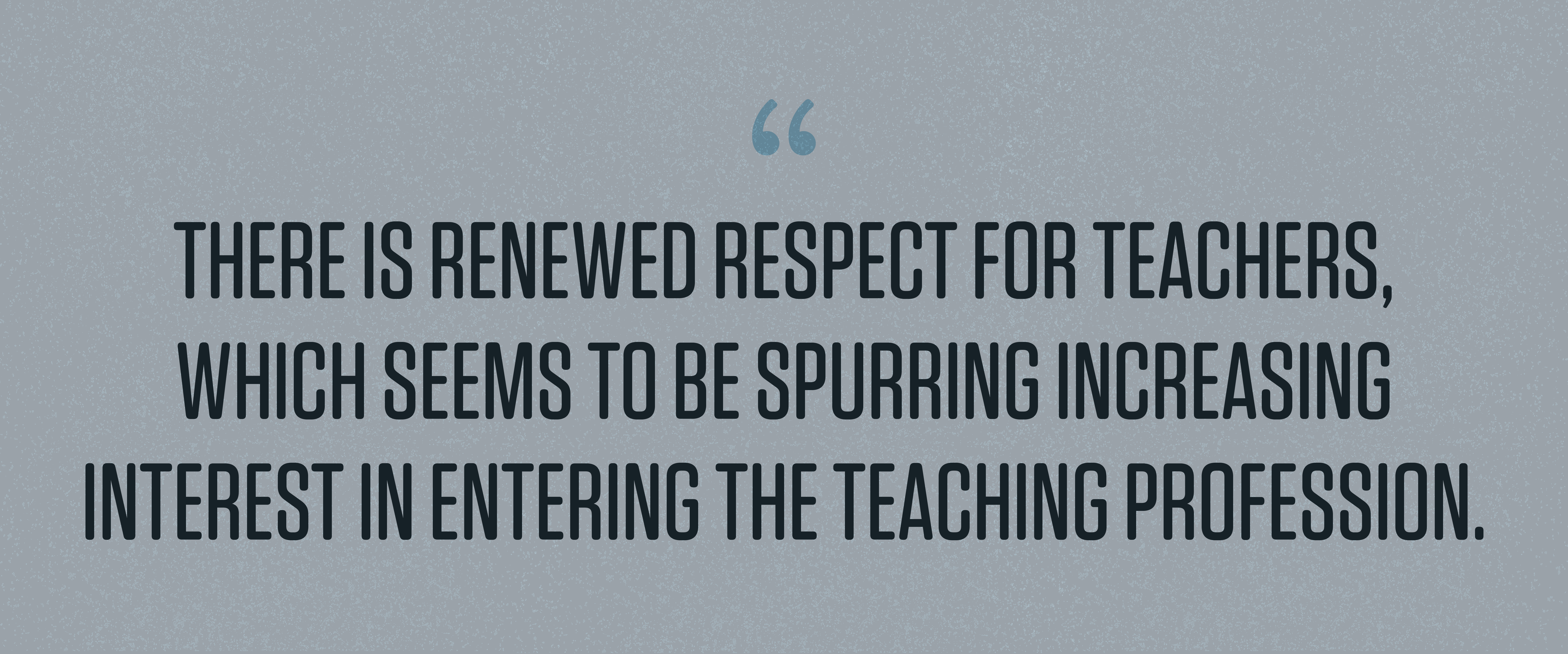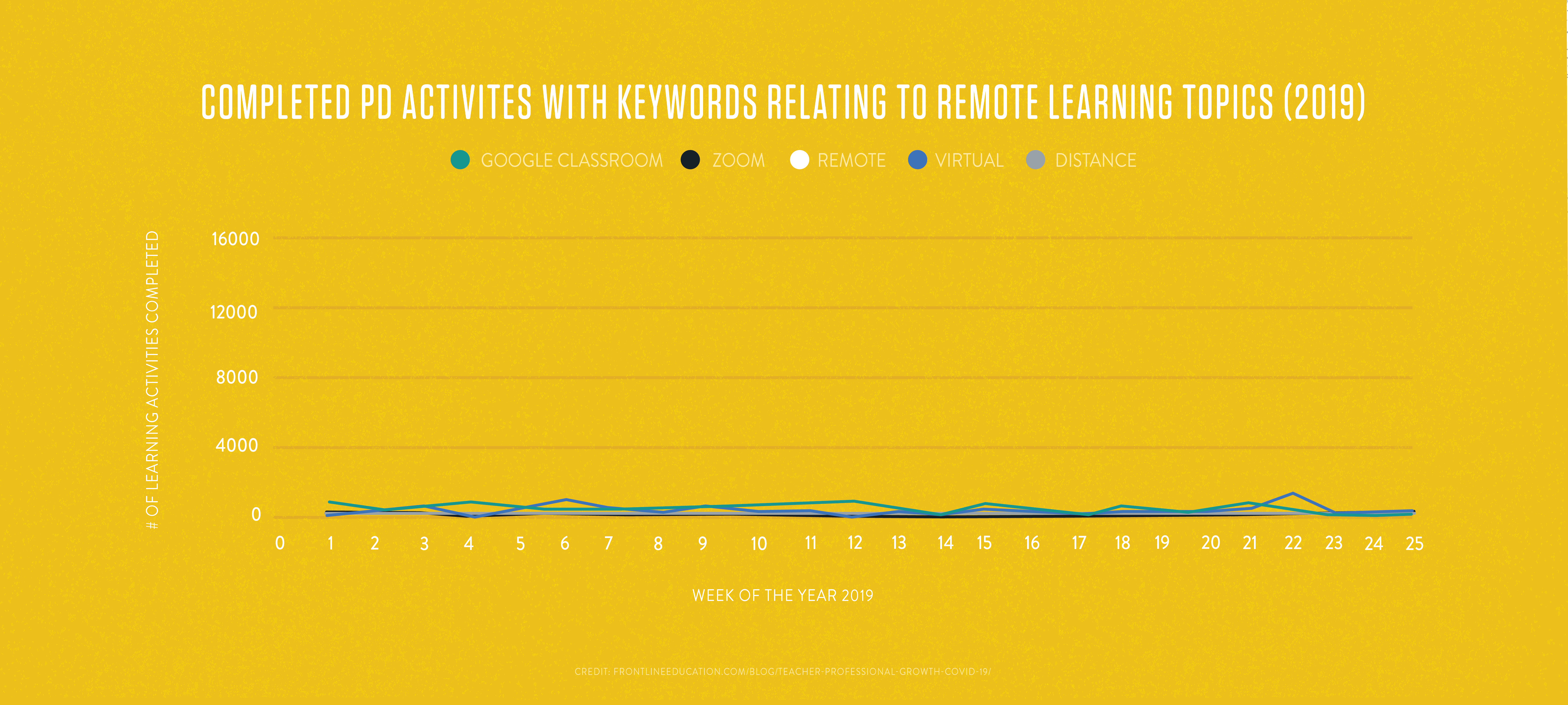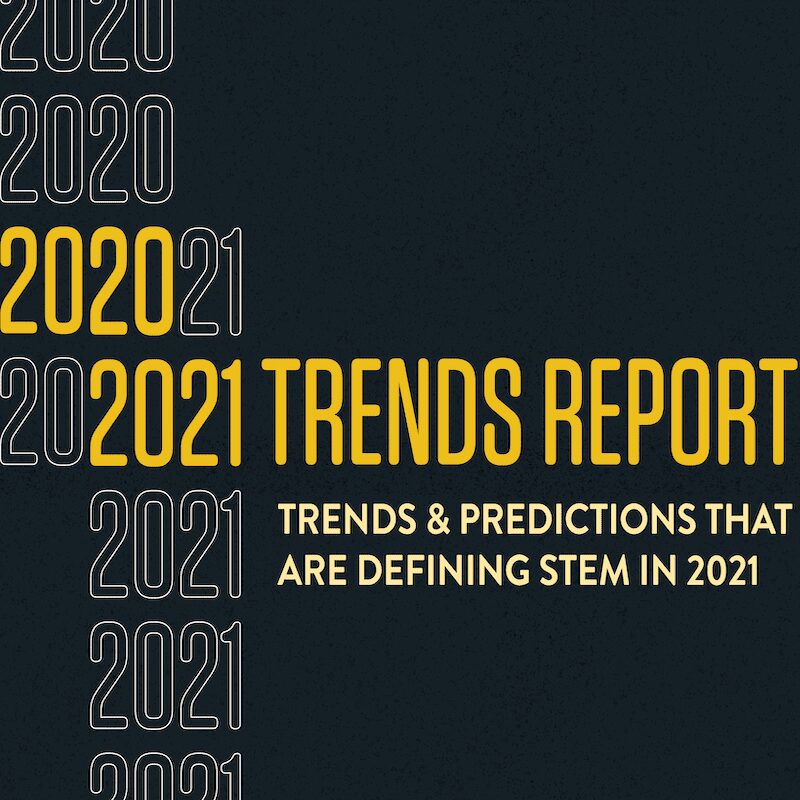
Since 2011, we’ve been working tirelessly to bring 100,000 excellent STEM teachers into classrooms nationwide, and all signs point to our surpassing this goal by the end of 2021.
As the backbone of a network of hundreds of diverse partners across the STEM field, we spend time each year distilling rising trends, innovative ideas, and insights in our annual Trends Report. This year, in response to these unprecedented times, we took a slightly different approach. With the clarity that being a few months into 2021 provides, we have a much better sense of the trends that will be most impactful as we emerge from the crises of the past year and reimagine a new “normal.
What we found was surprisingly optimistic. Amidst the devastation of COVID-19 and our country’s ongoing reckoning with racial and economic justice, we’ve seen some remarkable opportunities to leverage this moment to work toward deeper systemic change, not only in STEM, but across our entire education system.
The insights that follow emerge from dozens of interviews, listening sessions, one-on-one calls and group forums with folks on the frontlines across the education and STEM sectors. We hope these trends can help you develop new strategies, tools, and resources to better navigate these challenging times and continue to work collectively. This is what networked change looks like.

The phrase “crises accelerate existing trends” explains much of what we’re seeing in the education sphere in relation to racial and economic inequities. Covid-19 and our increased national consciousness around issues of racial injustice have revealed inequities we’ve previously ignored, and, in some cases, exacerbated further. Our partners who work closely with Departments of Education across the country reported that computer and internet access was divided sharply along race and class lines, often leading wealthier and more majority-white schools to quickly overcome the remote-learning hurdles of 2020, while underfunded and majority-BIPOC schools struggled to maintain a steady education for their students.One partner explained, “it’s hard to know if students are learning when they don’t turn their cameras on.” Further exacerbating this divide, according to a recent study, Black and Hispanic students were more likely than white students to have started the year remotely. This creates an undue burden on low-income and BIPOC students who may not feel comfortable giving their classmates and teachers the opportunity to see into their homes and private space. As one reporter wrote,“There are also cultural considerations: Students who wear hijab don’t typically cover their heads in the privacy of their homes—but they would have to put on the covering before turning their cameras on. And some students might not be able to use their cameras because they have low bandwidth or unstable internet connections.” Teachers have also reported increased challenges engaging parents and families, particularly undocumented parents. For our most vulnerable students, this confluence of challenges in school and at home put them at greater risk of dropping out of school entirely.

It’s clear that the pandemic is further revealing the structural inequities in education that systematically harm students of color at disproportionate rates. We believe that in 2021, we’ll see renewed focus, funding, and fortitude in addressing these inequities more directly and honestly than ever. As our partner Zulmara Cline, at the California State University, so aptly explained, “We need big structural change. Until we deal with structural challenges, we can’t make big changes here.” Across the board, we’re seeing our partners gravitate toward opportunities to do just that. Many 100Kin10 partners such as The University of South Carolina, Girl Scouts, and Western Governors University are leading the charge in spreading awareness and recommending solutions around issues of racial and economic justice in education.

For teachers, school administrators, and education advocates alike, the frantic shift to remote learning was a huge challenge. However, teachers proved resilient, developing new strategies and tactics nearly overnight in order to reach students through their computer screens.
After speaking with hundreds of teachers and school administrators from around the country, we’ve been fascinated and encouraged to see that this shift to online learning, something many teachers had dismissed, has led to an increased willingness to reconsider other long-held assumptions about education. Whether this is a passing phase born of necessity or a true shift in thinking is yet to be seen, but either way it’s clear that right now there’s an appetite for reimagining more than just the feasibility of online learning. We’re excited and eager to see renewed interest in questioning norms and a rekindled willingness to explore new (and old!) ideas.

- Grading: Across the country, many teachers have expressed questions about the cost/benefit of traditional grading. With all the upheaval, teachers were given permission to and developed new modes of assessment. We heard teachers debating whether eliminating grading takes the pressure off students or sets them up for failure in the future. In conversations with our partners, some shared concerns that grading is yet another aspect of education rife with racial bias, disproportionately harming students of color. In some cases we even saw students leading the way, petitioning their schools to reconsider grades. While grading might not disappear in 2021, we expect a reinvigorated debate on its usefulness and a re-imagining of the role of grading and feedback as a lever of change in education.
- Interesting to note: This is not only the case in PK-12. We’ve heard from partners in higher ed that teacher shortages have led to increased calls for performance-based certifications rather than tests and college GPA scores. Partners like TNTP are working to explore whether states might be open to these types of shifts post-pandemic.
- Attendance: In the BC (before COVID-19) days, showing up in class counted as attendance. Sure, there were points for participation, but your seat time was measured by whether you showed up. In our COVID-19 world, it is becoming increasingly clear to teachers – as students have joined class but are obviously somewhere else, either literally or metaphorically – that attendance might be a necessary but insufficient indicator of learning, and it’s engagement, not presence, that should “count” as attendance. 100Kin10 Teacher Forum members shared that students who were generally tuned out tuned back in when offered hands-on projects, so perhaps a focus on engagement would lead to more engaging pedagogy.
- Schedules: As any highschool teacher (or parent) can tell you, teenagers do not like waking up early, and one unexpected benefit of COVID-19 is that schools can start later, lining up better with kids’ circadian rhythms. A recent study indicates this may have significant mental and physical health benefits for students and has led more teachers and school administrators to reconsider early school start times.

In 2020, teachers had to adapt to a wildly new context, simultaneously teaching in-person and online, shifting schedules multiple times to accommodate shut downs and closures, and all the while still being expected to cover the same material. Many teachers have been going nonstop since March, leading remote summer school classes for students who fell behind, working through summer and fall breaks to craft new curriculum tailored for online learning, and, in some cases, returning to in-person teaching before the risks of doing so were fully known. At the 100Kin10 Teacher Forum, even veteran teachers said this was the hardest year they’ve ever experienced. The fatigue of dealing with this constantly shifting landscape is real.

However, we’ve seen teachers elevated to something like local heroes, rebranded as essential workers. At 100Kin10, we happily added our voice to that chorus and encouraged our network of partners to do so as well in our Love Letter to Teachers, which garnered hundreds of signatures (including Chelsea Clinton and former U.S. Secretary of Education, John King). This renewed respect for teachers is spurring increasing interest in entering the teaching profession. We’ve been inspired to hear from our partners around the country, like UTeach, Teach for America, California State University, Relay Graduate School of Education and TNTP, that teacher recruitment is on the rise, and Western Governors University saw growth in new enrollments and faster progress toward graduation and teacher certification. As Shirley Malcom, Head of Education and Human Resources Programs of the American Association for the Advancement of Science, told us: “I think a lot of people are giving the helping professions a fresh look.”
This year, teacher preparation institutions in 100Kin10 prepared more teachers than in any other year, a sign of hope that surprised even our optimistic team. In the near term, teacher shortages that long preceded the pandemic have continued and are expected to persist beyond COVID-19. With more teachers coming into the pipeline in 2021, though, we’re hopeful that 2020 has sparked the beginnings of a fundamental shift in how our nation respects and honors teachers, and we’re eager to see what this might mean for the future of teacher recruitment and retention.

Teachers have reported experiencing immense professional isolation during the pandemic, as they have fewer opportunities to interact with their colleagues, on whom they would normally rely for growth, support, and professional development. This hits rural teachers especially hard, but even in urban areas, teachers have been reporting feeling more isolated than ever before, particularly missing the informal and unplanned interactions they’d had with colleagues. At the same time, we’ve long known that teachers have felt exhausted by professional development requirements, which too often seem to serve as additional expectations to fulfill, rather than opportunities to build skills and find useful support.


We were surprised to learn how isolation and a need for specific professional development intersected in 2020 to spur something better. New forms of PD emerged – teacher-initiated and -designed to meet their needs as efficiently as possible. Teachers are collaborating through online groups and learning communities, launching various PD-style communities that seem to be operating with a “light and lean” mentality, shifting from transactional PD to peer-led PD that’s flexible, responsive and more participatory. Teachers have also doubled down on and gotten greater value from making connections with each other online, often referencing specific teacher Facebook pages that have proven invaluable in their transition to online teaching, leading us to reconsider what PD looks like in a post-COVID world and how we think about the ways teachers engage with it.

In a year marked by unprecedented changes, we’ve been inspired to see how quickly teachers have responded to new challenges and turned them into opportunities for addressing the deeply rooted issues at the core of our education system. As we reimagine what the education system will look like, we must take care to continue advancing STEM subjects that are too often the first on the chopping block when retrenchment into the traditional core content areas happens. As we’ve seen in other areas, the urgency that COVID-19 necessitated has sometimes led to decisions that further exacerbate existing deficits, but another way forward is possible. As we’ve seen STEM educators around the country lead the way in developing new solutions, we’re hopeful that the STEM and broader education communities will rise up to meet them and join forces in building a future in which every student has access to the STEM learning and opportunities they need to become the innovators our planet and country need them to be.



